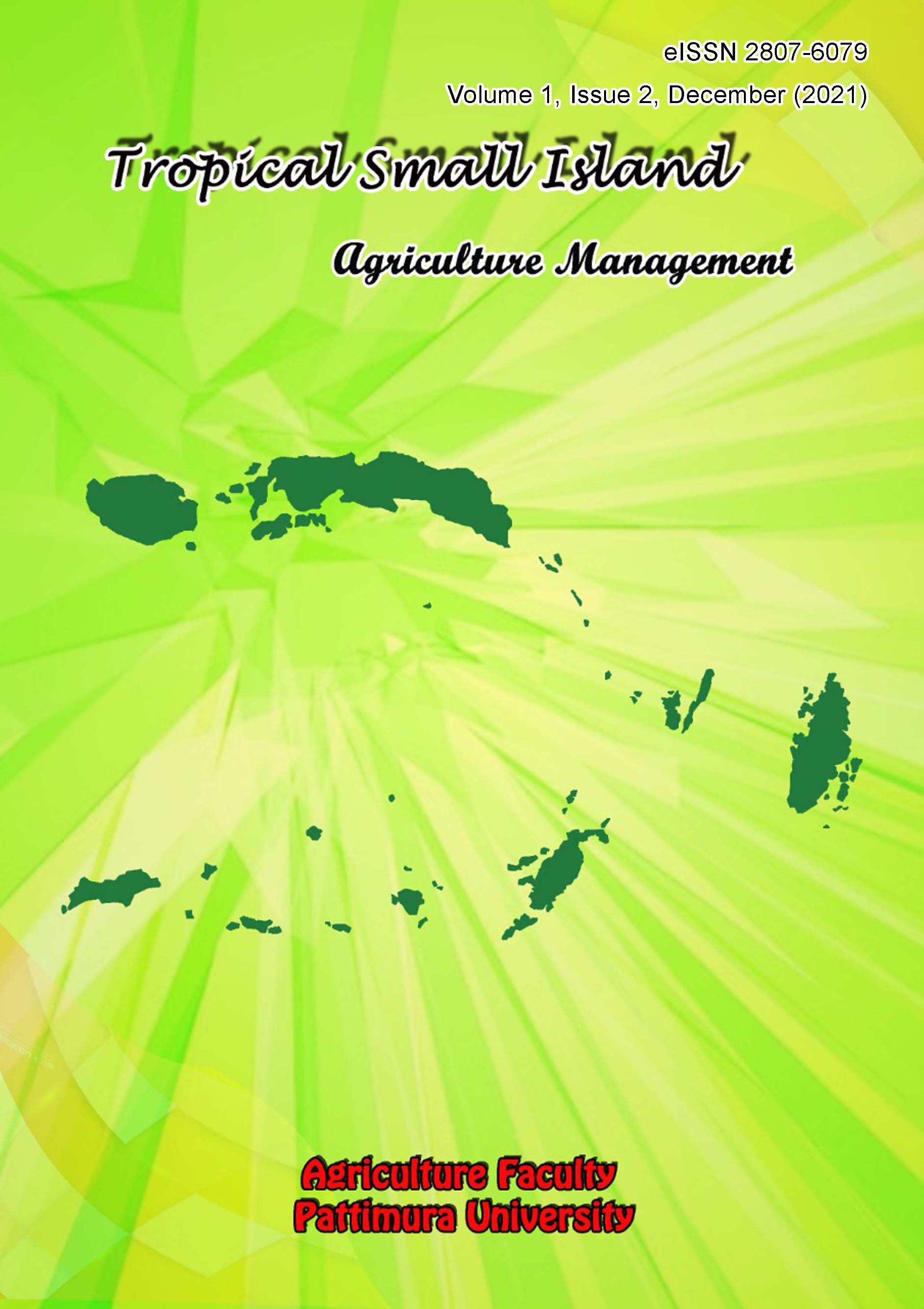Keanekaragaman Jamur Makroskopis Di Kecamatan Amahai Kabupaten Maluku Tengah
Macroscopic Fungi Diversity in Amahai District, Central Maluku Regency
Abstract
The research objectives are: 1) Identifying the types of macroscopic fungi found in Amahai District; 2) Calculate the frequency of presence and population of macroscopic fungi found in Amahai District, and 3) Describe the morphological characteristics of macroscopic fungi found in the Amahai sub-district. This research was carried out in Amahai District in the villages of Yafila and Nuweletetu. This research was also carried out at the Plant Disease Laboratory, Faculty of Agriculture, Pattimura University, from March to May 2024. The survey was carried out using the roaming method to obtain macroscopic fungi in Amahai District. The transect line created as a sampling location measures 100 ´ 20 m. Laboratory identification is carried out to determine the morphological characteristics of the fungus. Mushroom characteristics include fruit body shape, color, size, and habitat. The results (PCA) of 13 morphological characters from 38 fungi samples showed that between the two groups of macroscopic fungi, there was a similarity in morphological characters of 62%. Principle component analysis (PCA-Biplot) was performed on nine morphological characters on 38 macroscopic fungi samples. PCA was carried out to obtain characteristic characters in the fungi groups found. Based on the results of the analysis (PCA), the fruit's body shape and pores can be recommended as characterizing characteristics.
Downloads
References
Al-Thani, R.F. (2010). Survey of macrofungi (including Truffles) in Qatar. Atlas J. Biol. 1, 26–29. Doi: 10.5147/ajb.v1i2.5
Anggo, S., Nurlia, N., & Puwa, M.N. (2021). Inventarisasi Jamur Basidiomycota di Hutan Batu Tikar Kecamatan Luwuk Kabupaten Banggai. Bionature, 22(2), 13-29. https://doi.org/10.35580/bionature.v22i2.24277
Barreira, J.C., Oliveira, M.B.P., & Ferreira, I.C. (2014). Development of a novel methodology for the analysis of ergosterol in mushrooms. Food Anal. Method 7, 217–223. doi: 10.1007/s12161-013-9621-9
Chun-Ying, D. E. N. G., Tai-Hui, L., & Bin, S. O. N. G. (2011). A revised checklist of Marasmiellus for China Mainland. Czech Mycology, 63(2), 203-214.
CNN Health (2018). The humble mushroom is the newest superfood. Available Online at: https://edition.cnn.com/2018/04/25/health/mushroo,s-foodpartner/index.html (accessed April 25, 2018). Coetzee, M. P., Marincowitz, S., Muthelo, V. G., and Wingfield, M. J. (2015).
Desjardin, D.E., Wood, M.G., & Stevens, F.A. (2014). CALIFORNIA MUSHROOMS The Comprehensive Identification Guide. Timber Press. Portland-London.
Emberger, G. (2008). Fungi Growing on Wood. Messiah College (online) (https://www.messiah.edu/Oakes/fungi_on_wood, Diakses 17 Juni 2024)
Enow, E. (2013). Diversity and distribution of macrofungi (mushrooms) in the Mount Cameroon Region. J. Ecol. Nat. Environ. 5, 318–334. doi: 10.5897/ jene2013.0397
Hall, I.R. (2003). Edible And Poisonous Mushrooms Of The World. Timber Press. Portland-Cambridge.
Heleno, S.A., Barros, L., Martins, A., Morales, P., Fernández-Ruiz, V., Glamoclija, J., Sokoviv, M., & Ferreira, I.C.F.R. (2015). Nutritional value, bioactive compounds, antimicrobial activity and bioaccessibility studies with wild edible mushrooms. LWT - Food Science and Technology 63(2), 799–806. https://doi.org/10.1016/j.lwt.2015.04.028.
Huffman, D.M. (2008). Mushrooms and Other Fungi of the Midcontinental United States. University of Iowa Press.
Juminarti, L. (2011). Keanekaragaman Jenis Jamur Kayu Makroskopis Dalam Kawasan Hutan Adat Pengajit Desa Sahan Kecamatan Seluas Kabupaten Bengkayang. Skripsi. Pontianak: Fakultas Kehutanan Universitas Tanjungpura Pontianak.
Khatua, S., Paul, S., & Acharya, K. (2013). Mushroom as the potential source of a new generation of antioxidants: A review. Res. J. Pharm. Technol. 6, 496–505.
Kumar, K. (2015). Role of edible mushrooms as functional foods review. South Asian. J. Food Technol. Environ. 1, 211–218. doi: 10.46370/sajfte.2015. v01i03and04.02
Methven, A.S. & Kuo, M. (2014). Mushrooms of the Midwest. Universitas of Illinois Press, Chicago.
Manikandan, K. (2011). Nutritional and Medicinal Values of Mushrooms. Pp. 11- In Mushrooms, Cultivation, Marketing, and Consumption. Edition 1. Singh, M., Vijay, B., Wakchaurae, S.K.G.C.. (Eds.) Solan: Directorate of Mushroom Research. 9–12.
McKnight, K.H. & Vera, B.M. (1987). Mushrooms. New York: Houghton Mifflin Company.
Meena, B., Sivakumar, V., & Praneetha, S. (2020). Prospects of biodiversity and distribution of mushroom fungi in India. GSC Biol. Pharm. Sci. 13, 078–085.
Muniarti, N. (2010). Keanekaragaman Jenis Jamur Kayu Makroskopis di Hutan Rawa Gambut Pada Plot Permanen Simpur Hutan Desa Kuala Dua Kabupaten Kubu Raya, Universitas Tanjungpura, Fakultas Kehutanan, Pontianak.
Okhuoya, J., Akpaja, E., Osemwegie, O., Oghenekaro, A., & Ihayere, C. (2010). Nigerian mushrooms: Underutilized non-wood forest resources. J. Appl. Sci. Environ. Manage. 14, 43–54.
Okwulchie, I.C., & Odunze, E.I. (2004). Evaluation of the nutritional value of some tropical edible mushrooms. J. Sustain. Agric. Environ. 6, 157–162.
Oommen (2021). Hare's foot Inkcap or Woolly Inkcap - Coprinopsis lagopus, species information page. Also known as Fairies Shelter" https://www.brickfieldspark.org/data/fungiharesfootinkcap, Diakses 17 Juni 2024)
Putri, A.T. (2020). Identifikasi Jamur Makroskopis di Taman Wisata Alam Deleng Lancuk Kabupaten Karo Sumatera Utara. Skripsi. Universitas Islam Negeri Sumatera Utara.
Roupas, P., Keogh, J., Noakes, M., & Taylor, P. (2012). The role of edible mushrooms in health: Evaluation of the evidence. J. Funct. Foods 4, 687–709. doi: 10.1016/j.jff.2012.05.003
Rutherford, M. (2020). Podoscypha petalodes. https://www.inaturalist.org/photos/75479977, Diakses 17 Mei 2024.
Ruthes, A.C., Smiderle, F.R., & Iacomini, M. (2016). Mushroom heteropolysaccharides: A review on their sources, structure and biological effects. Carbohydrate Polymers, 136, 358–375. doi: 10.1016/j.carbpol.2015.08.061
Singh, S.S., Wang, H., Chan, Y.S., Pan, W., Dan, X., Yin, C.M., Akkouh, O. And Ng, T.B. (2015). Lectins from edible mushrooms. Molecules, 20, 446–469. doi: 10.3390/ molecules20010446.
Tampubolon, S.D.B.M. (2010). Keanekaragaman Jamur Makroskopis di Hutan Pendidikan Universitas Sumatera Utara Desa Tongkoh Kabupaten Karo Sumatera Utara. Skripsi. Program Studi Kehutanan, Fakultas Pertanian, Universitas Sumatera Utara.
Tel-Cayan, T., Ozturk, G., Duru, M.M.E., & Turkoglu, A. (2017). Fatty acid profiles in wild mushroom species from Anatolia. Chem. Nat. Compd. 53, 351–353. doi: 10.1007/s10600-017-1986-3
Wings, A. (2012). Maryland Biodiversity Project (Pleurocybella porrigens). https://www.marylandbiodiversity.com/view/15468. Diakses 17 Juni 2024.
Copyright (c) 2024 The Author(s)

This work is licensed under a Creative Commons Attribution-ShareAlike 4.0 International License.
Authors who publish with this journal agree to the following terms:
- Authors retain copyright and grant the journal right of first publication with the work simultaneously licensed under a Creative Commons Attribution License that allows others to share the work with an acknowledgment of the work's authorship and initial publication in this journal.
- Authors are able to enter into separate, additional contractual arrangements for the non-exclusive distribution of the journal's published version of the work (e.g., post it to an institutional repository or publish it in a book), with an acknowledgment of its initial publication in this journal.
- Authors are permitted and encouraged to post their work online (e.g., in institutional repositories or on their website) prior to and during the submission process, as it can lead to productive exchanges, as well as earlier and greater citation of published work (See The Effect of Open Access).









